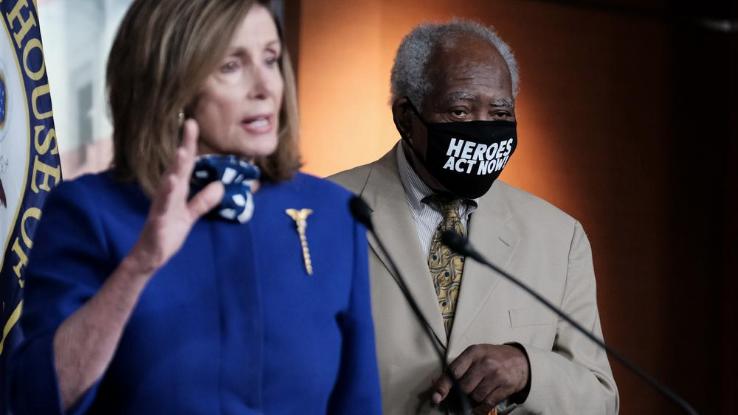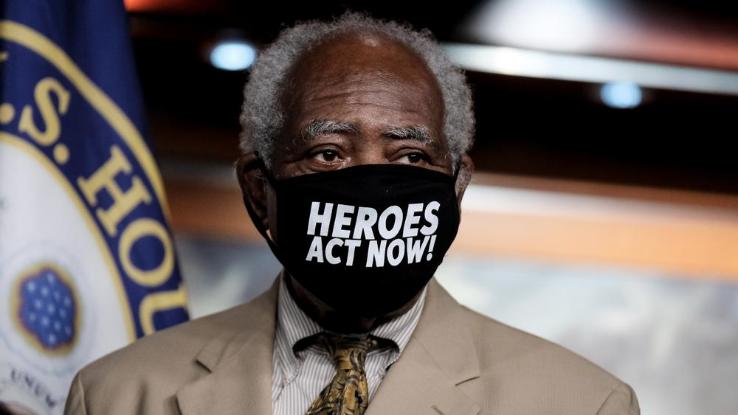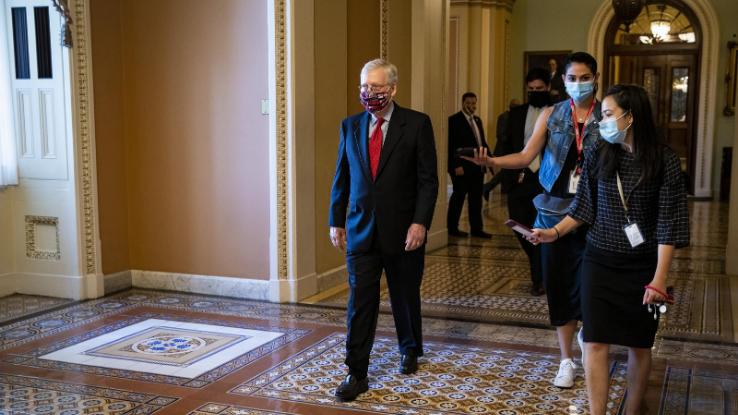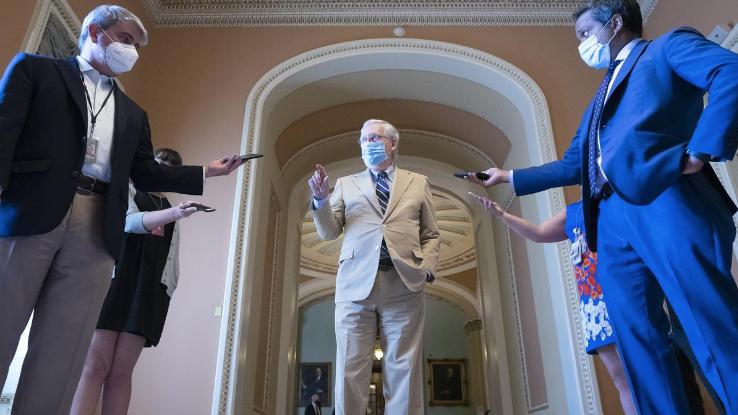
Updated | January 19: Following months of ongoing relief legislation negotiations between House and Senate Democrats and Republicans — and while Congress remained unable to broker a compromise even in the face of multiple big-budget proposals — a second stimulus check has been authorized and is now being disbursed. Another potential package with stimulus payments may still be on the horizon, but this won’t see approval until after President Biden takes office.
On March 27, federal lawmakers enacted a $2.2 trillion economic stimulus package, known as the CARES Act, in order to help Americans navigate financial hardships in the wake of the novel coronavirus pandemic. Among its many benefits, the act increased federal unemployment to $600 a week and provided many Americans with relief checks — one-time payments totaling up to $1,200 per individual who reported an adjusted gross income of $75,000 or less in 2019. While the one-time $1,200 relief check certainly helped, millions of unemployed Americans felt (and still feel) that it didn’t go far enough in mitigating the financial burdens caused by the COVID-19 pandemic.
In the months following the CARES Act’s passing, Congress continually failed to broker and distribute a second relief package with stimulus checks to assist Americans in weathering the struggles the COVID-19 crisis has caused. Multiple proposals looked promising but ultimately didn’t pass. After back-and-forth negotiations failed to result in an agreement for almost eight months, Congress finally approved the Consolidated Appropriations Act, a second relief bill — one that included economic impact payments, the IRS’s term for stimulus money — just a few days before Christmas of 2020. Although the CARES Act’s relief checks paid out a more generous $1,200, the second package’s stimulus checks ended up paying out $600 to eligible Americans, despite whispers of a last-minute bid to push the amount to $2,000 per individual.
Now, amid confusion about the amounts of the $600 stimulus payments — more on that below — President Biden is reportedly putting together a multi-trillion-dollar stimulus package that would “boost stimulus payments for Americans to $2,000, extend unemployment insurance and send billions of dollars in aid to city and state governments,” reports The Washington Post. Although this third round of checks won’t take shape until after Biden takes office on January 20, it appears that even more relief may be on the horizon without another eight-month wait.
How Do the Various Proposals and Acts Compare?
The number of COVID-19-related relief package acronyms that were being thrown around has made things confusing. So, first things first: What are the key differences between all of these acts? First up, the CARES Act was the $2.2 trillion economic stimulus package passed in March — it’s where that first round of relief checks and those enhanced unemployment benefits came from.

As for the follow-ups, the Democratic-led House of Representatives proposed the HEROES Act in May, calling for a relief package worth triple what Republicans aimed to spend in their counter-proposal, the HEALS Act. Efforts to reach a compromise between the two — and to pass the GOP’s subsequent “skinny bill” and the later March to Common Ground framework — completely fell flat, but calls for new proposals remained in the works. As potential new package proposals emerge, reviewing a quick comparison — particularly of how they relate to the CARES Act and the second stimulus, which are the only relief packages that have passed so far — can help cast light on what’s on the line.
The Acts at a Glance:
- CARES Act: In total, the package cost $2.2 trillion. It provided stimulus checks to many, but not all, Americans ($1,200 for single filers earning under $75,000 and $2,400 for joint filers under $125,000); provided an extra $500 for all dependents age 17 and under (excluding college students); provided enhanced unemployment benefits of $600 per week in addition to state benefits through July 31; allocated $659 billion in PPP loans for small businesses; and banned late fees until July 25 and evictions until August 24.
- HEROES Act: Coming in at $3 trillion, this proposal would’ve built off the CARES Act. Eligible Americans would’ve received $1,200, instead of $500, for up to three dependents per household. Enhanced unemployment benefits would’ve extended through January 2021 for most workers and continued through March 2021 for independent contractors, part-time workers, people who are self-employed and “gig” workers. PPP loan eligibility was set to expand, and the eviction moratorium would’ve been extended (and expanded who was covered under that) for an additional 12 months. Lastly, the act would’ve allocated $300 billion total for housing programs and rental assistance and provided $58 billion in funds for grade schools and $42 billion for higher education.
- HEALS Act: This package totaled $1 trillion in costs and, while it proposed to uphold the stimulus check payments of the CARES Act and expand relief money for dependents ($500 for all dependents, no age limit), it also made key changes. Unemployment benefits would’ve dropped to $200 per week through September, then gone up to $500 to match 70% of lost wages when added with state benefits. The act would’ve allocated $190 billion into the PPP fund and expanded eligibility while providing money for a “return to work” bonus for people who secured new jobs. It would’ve also provided $70 billion to K-12 schools, with the caveat that they had to open in person, and allocated $29 billion for higher education, $1 billion for the Bureau of Indian Education and $5 billion to be used at states’ discretion. The proposal also aimed to protect businesses and schools from being sued for COVID-related issues and intended to allocate $16 billion for novel coronavirus testing.
- The “Skinny Bill”: Introduced in August, this second GOP economic relief bill proposal was a much more pared-down offering than HEROES and HEALS. Compared to the $1 trillion cost of HEALS, this bill would’ve cost just $500 billion, with none of that money funding stimulus checks. Instead, it would’ve been allocated toward funding the U.S. Postal Service, testing for the coronavirus, the PPP fund, help for U.S. schools and the enhanced unemployment provisions Donald Trump outlined in previous executive orders to continue those payments. Unemployment payments under this act would’ve included $300 coming from the federal government and $100 from state governments, for a total of $400 per check through December 2020. Additionally, $10 billion would’ve gone towards funding the USPS.
- March to Common Ground: This bill, introduced in September neared the CARES Act in cost, potentially reaching $2 trillion, and again proposed one-time $1,200 stimulus checks for individuals along with one-time $500 payments per child or dependent adult. It also would’ve provided need-based rental assistance and allocated funds to support eviction moratoriums through January of 2021. In addition, March to Common Ground would’ve reserved $120 billion for unemployment funds and another $290 billion for small businesses and nonprofits, $240 billion of which would’ve gone towards PPP loans with the remainder reserved for various tax credits. Like the “skinny bill,” March to Common Ground also included funding for the USPS but bumped the amount up to $15 billion. In addition to over $500 billion for state aid, this plan would’ve directed $145 billion to schools and childcare programs and another $100 billion to COVID-19 testing and healthcare.
- Consolidated Appropriations Act (the second stimulus bill): Signed into law on December 27, 2020, one of this $900 billion package’s most anticipated elements is the provision of one-time, $600 economic impact payments to qualifying individuals and their dependents. Adults with an adjusted gross income of up to $75,000 (based on 2019 taxes) were eligible to receive the full $600, and payment amounts decreased commensurate with increases in income before phasing out completely for those who earned more than $99,000 in 2019. This second bill also continued the $300 weekly federal unemployment benefit payments until March 14 of 2021. A substantial $285 billion of the package’s $900 billion was apportioned for a continuance of the Paycheck Protection Program for businesses, along with an additional nearly $50 billion allocated towards purchasing and distributing COVID-19 vaccines and providing support to states for their testing and contact tracing programs. The bill also set aside $35 billion to fund clean energy projects and banned surprise medical bills, making it “illegal for hospitals to charge patients for services like emergency treatment by out-of-network doctors or transport in air ambulances that patients often have no say in accepting,” notes The New York Times.
Why Have These Proposed Acts Been So Hotly Contested?
As May 2020 bills loomed in the pandemic’s earlier days, Reps. Ro Khanna (D-Calif.) and Tim Ryan (D-Ohio) proposed the Emergency Money for the People Act (EMPA), which intended to provide stimulus payments of $2,000 a month to qualifying Americans for six months with the option to renew the program. Moreover, to account for the delayed CARES checks, EMPA would have allowed funds to be distributed by more 21st-century payment platforms, like Venmo and PayPal. Of course, that plan didn’t pan out.

In May, Democrats called for another round of $1,200 payments as part of their HEROES Act, which the House passed (but the Senate refused to take up). The Republicans’ HEALS Act, which was introduced by Senate Majority Leader Mitch McConnell (R-Ky.) on July 27, also outlined a plan for a second round of $1,200 stimulus checks.
While the Republican-helmed HEALS Act initially seemed to be the frontrunner, both HEROES and HEALS were hotly contested. And as multiple follow-up proposals fell flat, things became even more complicated. Democrats objected to the HEALS Act because it didn’t extend unemployment benefits in full; they were also pushing for larger stimulus checks and $1 trillion in state aid.
Why did negotiations between HEALS and HEROES fall apart? Democratic House Speaker Nancy Pelosi summed it up by noting, “We’re very far apart. It’s very unfortunate.” The two parties ultimately failed to reach a satisfying agreement because what the groups wanted from their separate plans was so different that it was difficult to find common ground on which to work things out. And the “skinny bill” left both sides with less to work with — the simplified offering failed to make it easier to focus on the few specific issues it did address.
In addition, the bipartisan March to Common Ground proposal began facing criticism almost immediately following its introduction. Top House Democrats noted that the plan did provide a usable framework that future bills could build off of in hopes of a compromise, but they also said that it ultimately didn’t do enough to limit the struggles many Americans had been facing throughout the pandemic. In a joint statement, House committee leaders noted, “While we appreciate every attempt at providing critical relief to American families, the…proposal falls short of what is needed to save lives and boost the economy.” According to Li Zhou of Vox, the cost of the bill was likely also higher than what Republican leaders would’ve been comfortable with. Although March for Common Ground faced quick dismissal, pressure to find a solution mounted, especially as the presidential election loomed.
The slow decision-making became incredibly frustrating, perhaps even more so for Americans without jobs since the $600 per week unemployment earnings ended on July 31 and the additional $400 weekly unemployment checks resulting from Donald Trump’s executive order to restart those payments were largely no longer being provided by most states. According to CNBC, these proposals would “impact nearly 32 million Americans currently receiving unemployment benefits — about five times the level of the Great Recession more than a decade ago.” Then, after months of waiting, millions of Americans finally saw more aid with the passing of the Consolidated Appropriations Act. And it wasn’t without its own form of confusion.
Even the second stimulus bill faced hurdles from the outset, particularly when it came to the amounts of the proposed economic impact payments. Although Congress finally reached an agreement that included one-time $600 payments to eligible Americans, Donald Trump reportedly called the package and that amount a “disgrace” and claimed he wouldn’t sign the bill into law unless the payments were upped to $2,000. Trump ended up signing the package into law with the $600 payment amount intact. Just days later, the House of Representatives voted to increase the payments to $2,000 and give eligible Americans up to $1,400 more as part of the second package. However, former Senate Majority Leader Mitch McConnell refused to hold a vote on the second bill’s potential second payment, leaving many Americans wondering if they’d see additional aid.
Will There Be a Third Round of Stimulus Checks?
Although it’s unlikely anyone will receive a supplemental $1,400 check as a follow-up to the $600 payments the second stimulus bill provided, a third round of stimulus payments is still on the horizon. As mentioned, President Biden is already discussing a multi-trillion-dollar relief package that’s in the works — a package that would include $2,000 economic impact payments for Americans. This bill will likely also allocate billions of dollars in aid for schools, better vaccine distribution and rent forbearance. It may even bump up weekly federal unemployment assistance payments to $600.

Biden has acknowledged that “the price tag will be high” for this bill but has also stated that “we need to provide more immediate relief for families and businesses now,” according to The Washington Post. The president-elect further explained, “The overwhelming consensus among leading economists…is that in order to keep the economy from collapsing [in 2021]…we should be investing significant amounts of money right now.” Of course, it remains to be seen how a potential third bill will play out and what provisions it could ultimately end up offering. But it appears that providing more aid will be one of Biden’s central priorities when he takes office.
As negotiations continue and new proposals and discussions crop up, many Americans remain eager for more answers, direction and aid. Here’s hoping that all comes sooner rather than later.
Right now, decisions are still being made, and details remain up in the air. Please check back for the most up-to-date information on the second round of stimulus checks and COVID-19-related relief.






